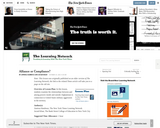
Students examine the relationships between and among powers inside and outside Afghanistan in connection to United States military aggression in the territory.
- Provider:
- New York Times
- Author:
- Annissa Hambouz, Javaid Khan
- Date Added:
- 06/24/2019

Students examine the relationships between and among powers inside and outside Afghanistan in connection to United States military aggression in the territory.

In this lesson, students examine the relationships between and among powers inside and outside Afghanistan in connection to United States military aggression in the territory.

This is the news article which is attached to the lesson plan of the same name.

In this lesson, students will use use editorial cartoons dealing with the anti-Vietnam conflict movement in order to determine aspects of this protest movement. They will consider the causes, forms and effectiveness of protest as depicted in editorial cartoons.
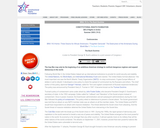
In this lesson, students will examine the background and contents of the Bush Doctrine. A set of discussion questions is provided. In an associated activity, students will research current African American leaders and their views on current issues. The students will debate whether or not the Bush Doctrine should be part of the U.S. foreign policy.

Kick-off a research project on gender roles on the World War II home front with two brief video clips and a selection of primary sources. Once students have analyzed the photographs and wartime advertisements, begin a research project on women during World War II. This lesson plan (which includes background information and full-color primary sources) was produced to accompany the exhibition "The Price of Freedom: Americans at War," by the Smithsonian?s National Museum of American History.
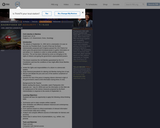
This lesson examines the civil liberties guaranteed by the U.S. Constitution and how the conditions of war might affect those liberties. Students will: review the rights and responsibilities of a citizen in a democratic system; study historical precedents for altering civil liberties during time of war; discuss and debate the pros and cons of the wartime curtailment of civil liberties; examine the role of the press in keeping citizens informed in light of the government's need to limit information during times of crisis.
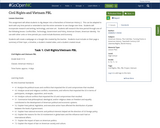
This assignment will allow students to dig deeper into a theme/lens of American History 2. This can be adapted to work with any time period or extended to last the entire semester to see change over time. Students will incorporate research and writing, technology, and even art. Students will research the time period through one of the following lenses: Conflict/War, Technology, Government and Policy, American Dream, American Identity. For use with other units or time periods you could include Business and Economy.Students will create a webpage on a Google Site created by the teacher. Students must include on their page a summary of their topic, a timeline, a student created video, and a student created visual.
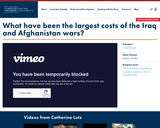
In this Teaching with the News lesson, students explore the human, economic, social, and political costs of the wars in Iraq and Afghanistan. There is an extension activity included for advanced students.

This resource provides facts, arguments, photos, video footage, etc. about the pros and cons of the Cuba Embargo; useful for teacher planning or student-friendly enough to use as a source for research.

Students will play the role of White House advisers, exploring policy options and recommending the best strategy for preventing war in East Asia.

In this lesson, students learn about the draft lottery during the Vietnam War, and how it affected the lives of young men during that time. Students are introduced to the Selective Service’s lottery system through a bell-ringer that asks them to locate their “number” and then segregates the class into the drafted and undrafted. They then read a short description of the Selective Service’s lottery system. The key points from the reading are summarized through a teacher-directed discussion. Finally, students view the oral histories of veterans who discuss the ways the draft impacted their perspectives on the Vietnam War.

In this lesson, students will collaboratively analyze the content of editorial cartoons that focus on the rise on Hitler's dominance of Europe. Students will also demonstrate their knowledge of the chronology of WWII in Europe by placing the cartoons in an order that shows a progression of WWII in Europe.

In this lesson, students analyze the changing perception of the Soviet Union in the eyes of American citizens from 1920 to 1950 by examining visual and written primary sources from the period.
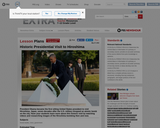
Students learn about President Obama's visit to Hiroshima, Japan by watching videos and researching images of the Hiroshima bombing then and now.
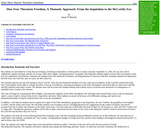
This curriculum unit from the Yale-New Haven Teachers Institute is designed to help students explore the essential question of "How has fear threatened freedom over time, with special emphasis on the Cold War and the McCarthy Era?" Each student will be able to evaluate the effect of fear on civil liberties, with special emphasis on the Fifth Amendment, and will be able to connect the Cold War and McCarthyism with current events.
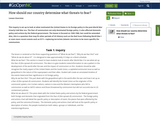
This inquiry is set up to look at what motivated the United States in its foreign policy in the post-World War II/early Cold War era. The fear of communism not only dominated foreign policy, it also affected domestic policy and actions by the federal government. The lesson is focused on 1945-1960, but could be extended. Also, this is a question that may fit other periods of US History such as the Red Scare following World War I or even more recent events such as 9/11—replacing terrorism (Islamic terrorism to be more specific) for communism.

In this lesson, students will use political cartoons to become familiar with the purpose of, and controversy surrounding the League of Nations.

This lesson plan will survey the nature of what Winston Churchill called the Grand Alliance between the United States, Great Britain, and the Soviet Union in opposition to the aggression of Nazi Germany and Imperial Japan.

American foreign policy resonates with the same issues as the debate over U.S. entry into the League of Nations-collective security versus national sovereignty, idealism versus pragmatism, the responsibilities of powerful nations, the use of force to accomplish idealistic goals, the idea of America. Understanding the debate over the League and the consequences of its ultimate failure provides insight into international affairs in the years since the end of the Great War and beyond. In this lesson, students read the words and listen to the voices of some central participants in the debate over the League of Nations.